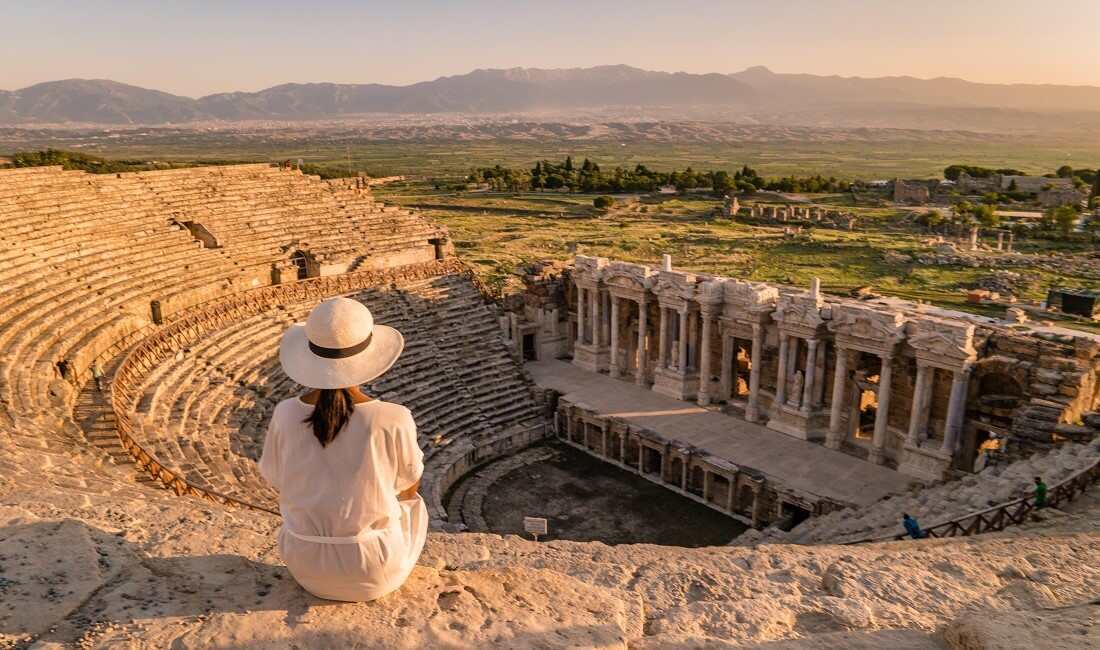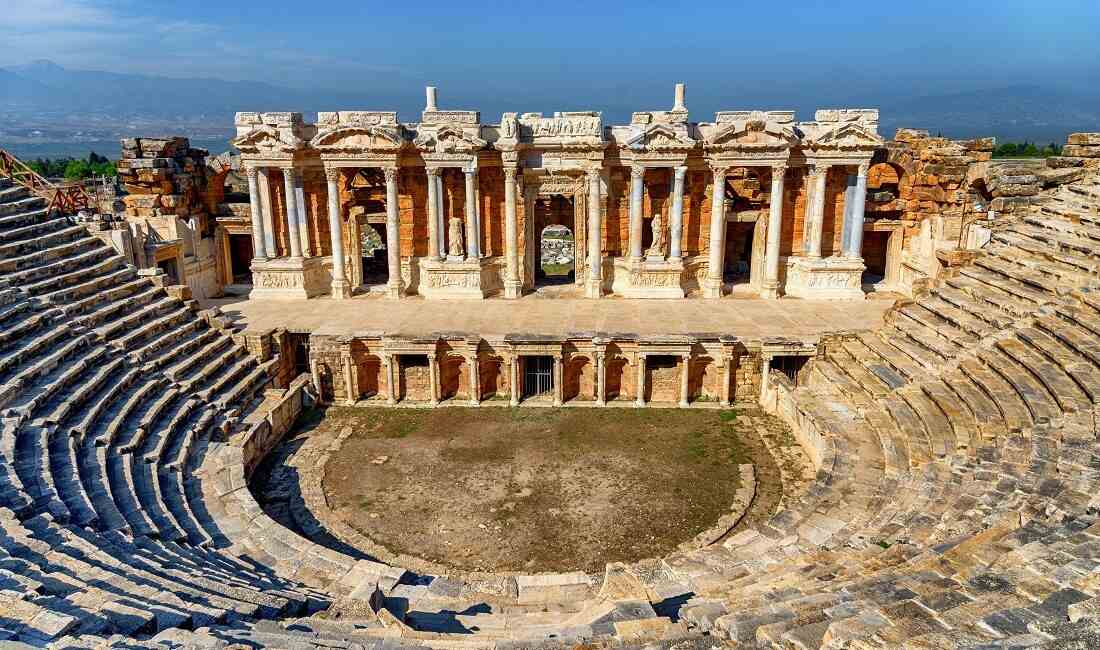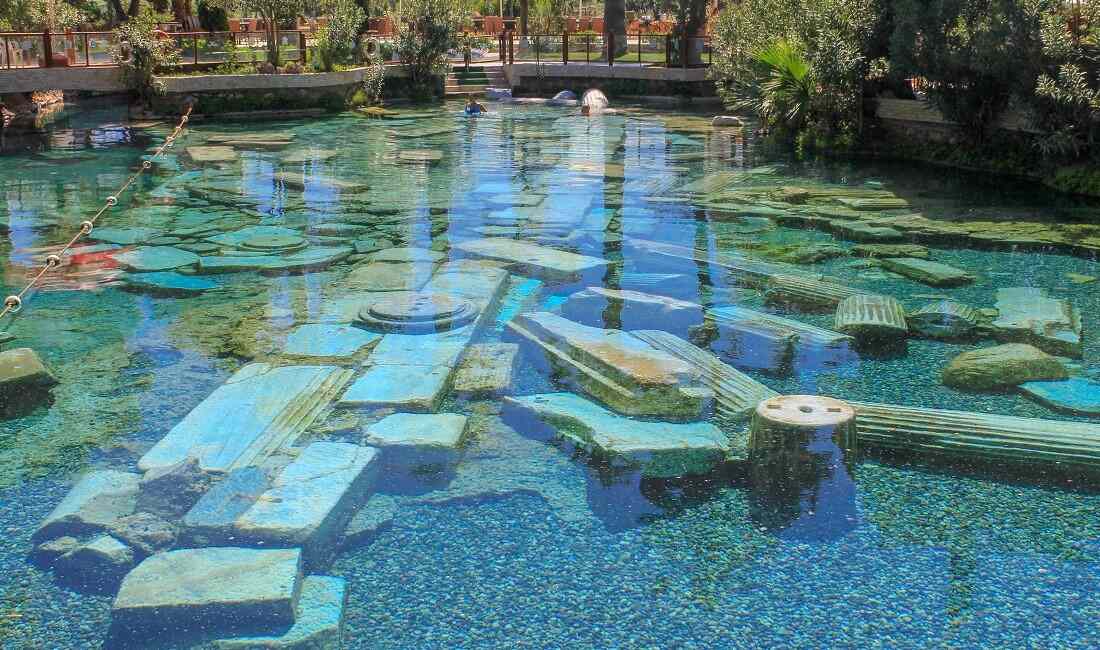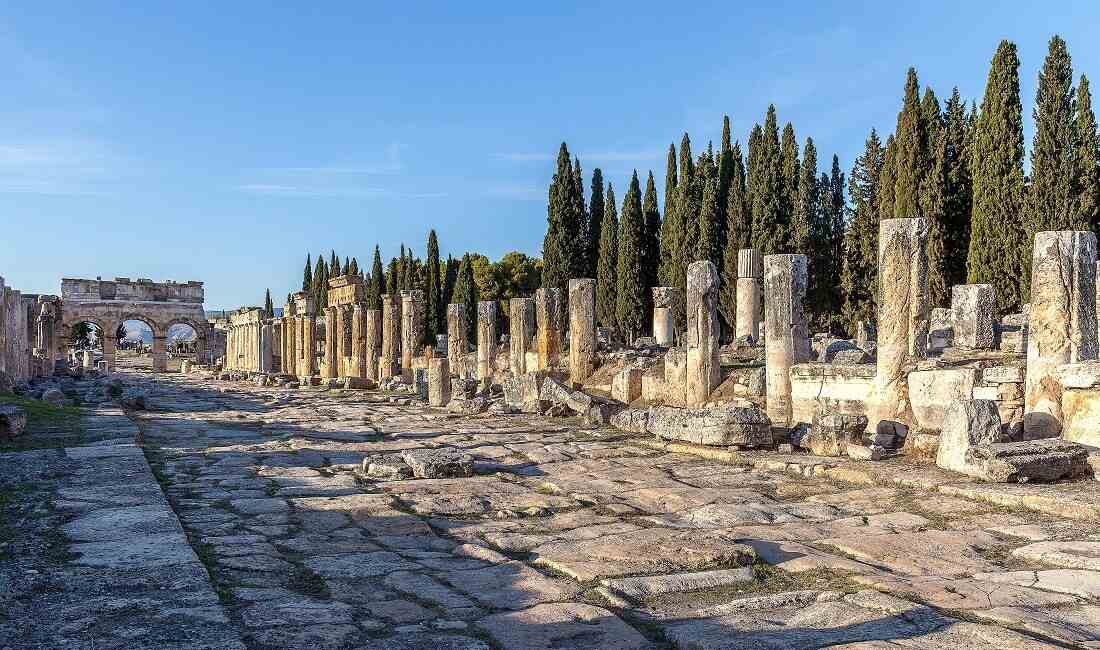
Welcome to a captivating journey through the wonders of Pamukkale and Hierapolis! Nestled in the beautiful country of Turkey, these two destinations hold a treasure trove of historical and geological significance that will leave you awe-inspired. This informative blog post will delve into the rich history, stunning natural formations, and cultural importance of Pamukkale and Hierapolis.
Pamukkale, which translates to “Cotton Castle” in Turkish, is a natural wonder that has captivated visitors for centuries. Its breathtaking travertine terraces, formed by the accumulation of calcium-rich mineral deposits over thousands of years, resemble a cascading white staircase. The brilliant white rocks of this geological wonder stand out dramatically against the lush background.
Adjacent to Pamukkale lies the ancient city of Hierapolis, a UNESCO World Heritage Site that dates back to the 2nd century BC. Hierapolis was founded as a thermal spa resort due to the area’s abundance of natural hot springs. The city flourished under various civilizations, including the Hellenistic, Roman, and Byzantine empires, leaving a remarkable archaeological site telling the story of its illustrious past.
As you embark on this virtual tour, imagine yourself walking through the ancient streets of Hierapolis, surrounded by well-preserved ruins, grand temples, and a magnificent theater that once hosted captivating performances. Picture yourself basking in the healing waters of Pamukkale’s thermal pools, indulging in the therapeutic properties of the natural springs.
These places are aesthetically pleasing and provide exciting insights into Turkey’s past and present. Pamukkale and Hierapolis have become symbols of national pride, attracting visitors from all corners of the globe who seek to explore their wonders.

Understanding the ancient roots and historical events that have molded Pamukkale and Hierapolis is crucial as we explore their fascinating world.
1. Ancient Origins of Hierapolis
The history of Hierapolis, whose name literally translates to “Sacred City” in Greek, dates back to the second century BC. Since there were so many natural hot springs in the area, the Attalid dynasty of Pergamon built the city as a spa destination. The healing properties of these thermal waters made Hierapolis a popular destination for those seeking relaxation and rejuvenation.
Over the centuries, Hierapolis experienced the influence of various civilizations. The Roman Empire, in particular, played a significant role in shaping the city’s architecture and cultural landscape. Under Roman rule, Hierapolis flourished, attracting wealthy patrons who built grand temples, lavish villas, and public baths adorned with intricate mosaics.
2. The Influences of Various Civilizations
The Roman Empire was not the only significant effect on Hierapolis. As more of the city’s past is uncovered, artifacts and structures from previous eras become visible. As a result, a unique synthesis of Greek and Anatolian architectural styles and aesthetic expressions emerged throughout the Hellenistic period.
Furthermore, Hierapolis experienced a revival during the Byzantine era as it became an important Christian center. Churches and monasteries were erected, and the city became a pilgrimage site due to its association with the biblical figure of St. Philip. The Christian influence is visible in the beautiful frescoes and religious artifacts discovered in archaeological digs.
3. Historical Events That Shaped Pamukkale and Hierapolis
Throughout history, Pamukkale and Hierapolis have witnessed significant events shaping their destiny. One such event occurred in the 7th century AD when a massive earthquake struck the region, causing extensive damage to the city. Despite this devastation, Hierapolis was rebuilt and continued to thrive.
Another pivotal moment in the history of Hierapolis was the decline of the Roman Empire and the subsequent transition to Byzantine rule. This shift changed religious practices and cultural norms, leaving a lasting impact on the city’s identity.
The rediscovery of Pamukkale and Hierapolis by modern-day explorers and archaeologists in the 19th century marked a turning point in their preservation and recognition as historical and natural treasures. The careful restoration efforts and ongoing excavations have unveiled the splendor of this ancient city and its geological wonders to the world.

The unique formation of the travertine terraces and the presence of natural hot springs create a breathtaking spectacle that has captivated visitors for centuries.
1. The Unique Formation of the Travertine Terraces
Pamukkale’s travertine terraces result from thousands of years of geological processes, making them truly one-of-a-kind. These terraces are formed by the precipitation of calcium carbonate from the flowing thermal waters. As the water emerges from underground springs and cascades down the slopes, it brings dissolved mineral deposits.
The calcium-rich water contains a high concentration of dissolved limestone, deposited on the surface as the water flows and evaporates. Over time, layer upon layer of these deposits builds up, creating stunning terraced formations that resemble a frozen waterfall or a cascading cotton-like structure.
What makes these terraces genuinely extraordinary is their dazzling white color. In addition, the high reflectivity of the calcium carbonate gives the terraces a pristine and ethereal appearance, especially when contrasted against the lush greenery of the surrounding landscape. It’s a sight that seems almost otherworldly, like stepping into a dreamlike paradise.
2. The Natural Hot Springs and Their Therapeutic Properties
Pamukkale’s natural hot springs are visually stunning and offer remarkable therapeutic benefits. Healing minerals like calcium, magnesium, and bicarbonate are abundant in the hot waters that flow through the terraces.
For centuries, people have flocked to Pamukkale to experience the rejuvenating effects of these hot springs. The warm water temperature, typically around 36-38 degrees Celsius (97-100 degrees Fahrenheit), helps to relax muscles, improve blood circulation, and alleviate various ailments such as rheumatism and skin conditions.
Taking a bath in one of these thermal pools is like visiting nature’s own spa and being a treat for the senses. The hot springs’ therapeutic qualities provide visitors a unique opportunity to unwind and find solace in the healing embrace of these natural wonders.
3. The Process of Calcium-Rich Water Creating the Dazzling White Terraces
The creation of Pamukkale’s dazzling white terraces is a fascinating natural phenomenon. It all begins deep beneath the surface, where underground hot springs bring calcium-rich water to the surface. These hot springs are fed by the geothermal activity in the region, as water seeps into the ground and get heated by the Earth’s internal heat sources.
When the water reaches the air at the surface, it begins to cool. This cooling process triggers the precipitation of calcium carbonate from the water, leading to the deposition of mineral-rich layers on the terraces. Over time, these layers solidify and form the distinct cascading structure we marvel at today.
The constant flow of water down the terraces ensures that the process of deposition and solidification continues, shaping the terraces and maintaining their pristine appearance. It’s an ongoing cycle of nature’s artistic creation, where water and minerals unite to sculpt a genuinely unparalleled masterpiece.
Now that we have explored the geological wonders of Pamukkale, it’s time to delve into the captivating history of Hierapolis. This ancient city stands in harmony with these natural marvels.

Hierapolis, located adjacent to Pamukkale, is a sprawling ancient city that covers a vast area. As you wander its streets, you’ll be immersed in the remnants of a once-thriving metropolis. The layout of Hierapolis is designed in a grid-like pattern, reflecting the urban planning of the time. The Frontinus Gate, an impressive entrance to the city, welcomes visitors with its grandeur and intricate architectural details.
One of the main attractions in Hierapolis is the Necropolis. This extensive ancient cemetery boasts an impressive collection of well-preserved tombs and sarcophagi. As you stroll through this Necropolis, you’ll be captivated by the intricate carvings and elaborate decorations adorning the final resting places of the city’s inhabitants.
Another notable feature of Hierapolis is the well-preserved ancient theater, a testament to the city’s grandeur and cultural significance. With a seating capacity of around 15,000 people, this theater was a venue for various performances and events during its heyday. Imagine the vibrant atmosphere as the audience gathered to witness theatrical plays, musical performances, and even gladiatorial contests.
The Hierapolis Theatre holds immense historical and architectural importance. Built during the Roman period, it showcases the expertise of ancient engineers and artisans. The theater’s design follows the typical Roman architectural style, with its semicircular shape and tiered seating arrangement.
In addition to its architectural splendor, the Hierapolis Theatre served as a cultural expression and entertainment platform. It was a hub for the creative community, and people from all over came to enjoy the shows. The theater’s acoustics were carefully crafted, ensuring every sound reached the audience with clarity and precision.
Today, the theater hosts cultural events and performances, bringing the echoes of the past to the present. Visitors can sit on the old stone benches and imagine themselves transported to a time when the theater buzzed with excitement and anticipation.
The Plutonium, a sacred site dedicated to the god Pluto, offers a glimpse into the spiritual beliefs of the ancient inhabitants of Hierapolis. It was revered religiously because of its status as a portal to the afterlife.
Another noteworthy landmark is the Temple of Apollo, an ancient sanctuary that honors the Greek god of the sun. The temple’s ruins stand as a reminder of the city’s religious practices and the influence of Greek mythology in the region.
You should also check out the Hierapolis Archaeological Museum. The museum has several items and exhibitions providing insight into the city’s history, culture, and daily life. In addition, artifacts from Hierapolis’ history, like sculptures and ceramics, are on show in the museum.
As you explore these archaeological ruins and historical landmarks, you’ll better understand the city’s past and the people who once called Hierapolis their home.

Both Pamukkale and Hierapolis are incredibly culturally significant for Turkey as a nation and the local community. These remarkable sites have garnered recognition on a global scale and continue to attract visitors from around the world, thanks to their unique features and historical significance.
For the local community residing near Pamukkale and Hierapolis, these sites are not only sources of pride but also vital to their identity and heritage. The locals value these locations highly due to their historical and cultural significance. In addition, it’s a reminder of the varied cultural traditions that have flourished in the region over the centuries.
Moreover, Pamukkale and Hierapolis contribute to the local economy through tourism. The influx of visitors allows the community to showcase its culture, traditions, and local craftsmanship. This interplay between tourism and local culture helps preserve and promote the region’s intangible heritage, ensuring its continued vitality.
On a national scale, Pamukkale and Hierapolis are cherished as symbols of Turkey’s historical legacy and cultural wealth. These sites serve as ambassadors, representing the nation’s heritage to the world and attracting travelers who seek to explore Turkey’s diverse history and cultural treasures.
In recognition of their outstanding universal value, Pamukkale and Hierapolis were designated as UNESCO World Heritage Sites in 1988. This prestigious status acknowledges the exceptional cultural and natural significance of the sites. Furthermore, it underscores their importance in the global context.
The UNESCO World Heritage Site status of Pamukkale and Hierapolis is a testament to their unique geological formations, historical landmarks, and archaeological remains. It also highlights their contribution to human history, offering insights into ancient civilizations’ development and cultural practices.
This recognition brings international attention to Pamukkale and Hierapolis, attracting scholars, researchers, and enthusiasts from various fields eager to study and learn from these great sites. It also promotes sustainable tourism and conservation efforts, ensuring these invaluable cultural treasures are preserved and safeguarded for future generations.

As you plan your visit to Pamukkale and Hierapolis, it’s natural to have questions about the best time to visit, safety concerns, accessibility, and other practical matters. Below are some of the most frequently asked questions and their answers.
1. What is the best season to visit Pamukkale and Hierapolis?
The best time to visit Pamukkale and Hierapolis is during the spring (April to June) and autumn (September to October) seasons. Temperatures in the 15-25 degrees Celsius (59-77 degrees Fahrenheit) range are typical for various times of the year. These seasons offer comfortable temperatures for exploring the sites and allow you to avoid the scorching summer heat and the occasional winter rainfall.
Pamukkale and Hierapolis may receive occasional rainfall in winter, and the terraces can be slippery. However, the advantage of visiting during winter (December to February) is the reduced number of tourists, allowing for a more peaceful and intimate experience. In addition, swimming in the ancient pool in winter is a fantastic experience.
2. Are the travertine terraces safe to walk on?
Yes, the travertine terraces in Pamukkale are safe to walk on. The natural formation of the terraces allows visitors to stroll along the designated paths and enjoy the stunning views. However, it’s essential to exercise caution and follow the guidelines to preserve the site and ensure your safety:
By respecting these guidelines, you can have a safe and enjoyable experience exploring the unique travertine terraces of Pamukkale.
3. Can visitors swim in the Pamukkale hot springs?
Yes, visitors have the opportunity to swim in the Pamukkale hot springs. There is a designated area known as the Antique Pool or Cleopatra’s Pool, where you can enjoy a refreshing swim amidst ancient ruins. The thermal waters of the pool are believed to have therapeutic properties, making it a unique and relaxing experience.
A fee is required to enter the Antique Pool area. The fee allows you to swim in the pool and enjoy the historical ambiance. Visitors are advised to check the current prices and any additional requirements before their visit.

4. Is Hierapolis accessible for people with mobility issues?
Visitors with disabilities can travel to Hierapolis. Ramps at the main entrance improve wheelchair accessibility. However, it’s important to note that the ancient city has uneven terrain, and some areas may be challenging to navigate.
To accommodate all visitors, there are accessible pathways that lead to the main attractions, such as the theater and the Necropolis. Additionally, the museum in Hierapolis is wheelchair-accessible, allowing everyone to explore the artifacts and exhibits.
For visitors with specific accessibility needs, it’s recommended to contact the site management in advance to inquire about any additional services or facilities that can enhance their experience.
5. How much time should I allocate to exploring Pamukkale and Hierapolis?
Pamukkale and Hierapolis are two places you should spend at least a half day, including the museum, look at the ruins of Hierapolis, and walk on the travertine steps. But, of course, spending a whole day at one of these great places is the best way to enjoy it if you have more time.
Think about which sights and experiences you’re most excited about. For example, if you’re passionate about history, allocate more time to explore the well-preserved ruins of Hierapolis. If you’re more focused on the natural wonders, spend extra time walking on the terraces and enjoying the hot springs.
By planning your time wisely and considering your interests, you can create an itinerary that suits your preferences and ensures a fulfilling experience.
6. Are there guided tours available at Pamukkale and Hierapolis?
Yes, guided tours are available at Pamukkale and Hierapolis, and they can significantly enhance your experience by providing valuable insights and historical context. Hiring a guide allows you to gain a deeper understanding of the site’s significance, learn interesting facts, and explore lesser-known areas.
